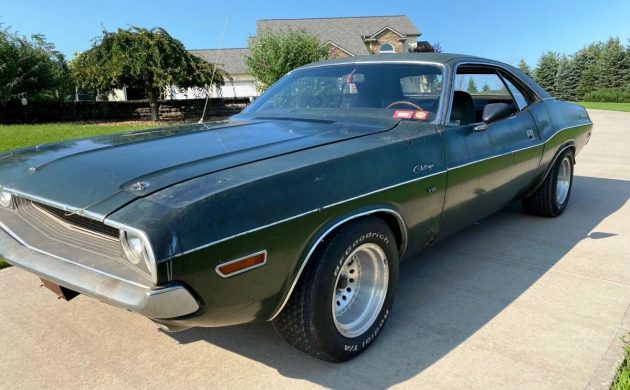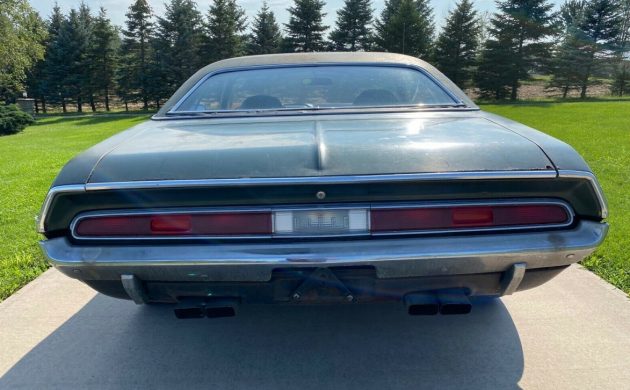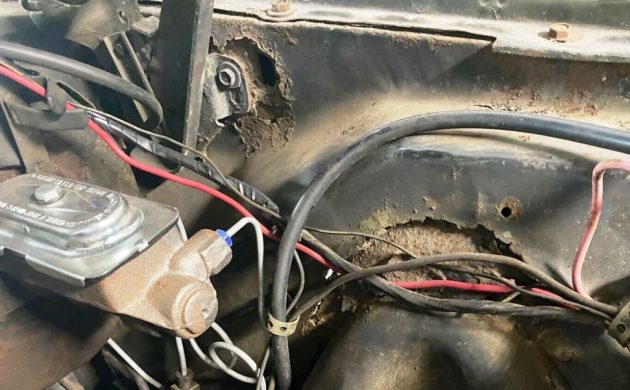Looking mean, green, and ready for a fight, this 1970 Dodge Challenger in Warners, New York runs and drives “real good” according to the seller. As eagle-eyed readers might surmise from the “V8” badge, this Dodge left the factory with a 318 V8, but a 340 powers it now, along with a four-speed manual gearbox in place of the original three-speed automatic. It’s got rust in the usual places for a New York classic, plus rust in somewhat unusual places as well. This true barn find has been gone through just enough to get it running and driving. With some potential demonstrated, it seeks a new owner here on eBay where at least eleven bidders have rolled the dice on the chance to give this car a second life. As we go to press, $5400 is the number to beat, but it will take more cabbage to crack the seller’s Reserve. Thanks to reader Larry D for spotting this Empire State pony car.
Both from Chrysler’s “LA” engine family, the 340 and 318 look similar externally, but the 340 was far more than a 318 with 22 extra cubic inches. The 318 primarily served as an entry-level V8 for family cars, while the 340 answered the call for a high-performance small-block that you might want for road racing, a pastime that Dodge and Plymouth E-bodies enjoyed with success. While there’s no way to know what flavor of 340 inhabits this engine bay, let’s discuss the basic 275 HP version. Much like the Ford Mustang’s Boss 302 and the Chevrolet Z/28’s 302, the 340 made more power on a dynamometer than it did on paper, and Motortrend saw 320 HP and 368 lb-ft of torque from a stock-spec 340. Forged rods, high-flow heads, a gnarly cam, and a 10.5:1 compression ratio earned the 340 a reputation for punching above its weight on the street and the track. Thanks to Wikipedia for some details.
Don’t dwell on the ripped seats of the green-on-green because nearly everything you see here will be replaced, and color doesn’t matter on a 340-swapped 318 car. Make like Sinatra and do it your way.
Still looking good back here, this barn find shows rust but fairly straight lines and trim.
The seller graciously includes a number of under-car shots but I’ve included this one to illustrate how not all rust repair is simply a matter of buying parts and bolting or welding them into place. Some rusty spots require structural work before you even get to where you can build it back cosmetically. I’m no E-body expert but I suspect this is not a fun place to repair. How would you rebuild this potentially surprising sleeper?







And it looks as if it got “all blowed up real good” too.
Wow.. this one is a hot mess!! I never seen holes or rust in these area and I have a 70 Challenger R/T. Something really happened here to get holes where it should not be. Way too much work and it’s a plain Challenger JH23GOB most likely. And the interior good Lord. Who ever gets it Good Luck!! 🇺🇸🐻🇺🇸
My car was identical to this one except for a 318. Actually gave it away to a friend when I realized it was more to deal with (rust) than I had the desire to deal with. Of course in 1980 there were not easily available floor and trunk replacements to be had for restoration.
The rust here is really wild…not sure if this is worth much effort at all. YMMV
If this is a native New Yorker, than it has survived rather well.
Stored in the Hudson?
None of that rust is atypical of these cars if you live in salt country, but it’s a ton of work for a 318 VIN. If you’re capable and really want it, go for it. If you’re going to pay someone to fix it, expect to spend about $20K just to get it in primer.
Bid’s at $10,100 as I type, with the reserve not met. That’s more than twice what this die-hard Mopar guy (and Challenger owner) would pay.
340s are freaks of nature. Seriously.